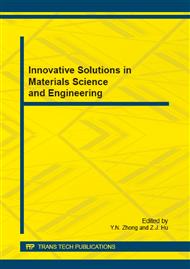p.3
p.7
p.12
p.17
p.21
p.27
p.31
p.35
Growth Processes of AC Powered Micro-Arc Oxidation Ceramic Film on Aluminum Alloy
Abstract:
Micro-arc oxidation technique was studied on the surface of 2A12 aluminum alloy using AC power in this paper. The micro-arc oxidation process was divided into several periods to investigate the changes of thickness and surface morphology of oxide film that forms in different periods and record the voltage change between oxide film. The following conclusions have been found: The growth of oxide film can be divided into three stages, the first stage is the formation and disruptive discharge of amorphous oxide film, producing the ceramic oxide granules; the second stage is the formation of ceramic oxide film, the ceramic oxide granules turns into porous structure oxide film in this stage; the third stage is the growth of ceramic oxide film, the gas film forms in the oxide film’s porous structure is electric broken-down, leading higher energy discharged by micro-arc, which becomes a significant reason for promoting the growth of ceramic film.
Info:
Periodical:
Pages:
7-11
Citation:
Online since:
November 2014
Authors:
Keywords:
Price:
Сopyright:
© 2015 Trans Tech Publications Ltd. All Rights Reserved
Share:
Citation:


